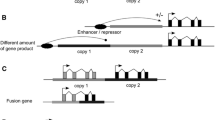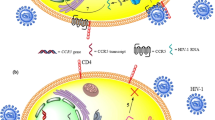Abstract
Genetic susceptibility to HIV infection was previously proven to be influenced by some chemokine receptor polymorphisms clustering on chromosome 3p21. Here the influence of 5 genetic variants was studied: Δ32CCR5, G(-2459)ACCR5, G190ACCR2, G744ACX3CR1 and C838TCX3CR1. They were screened in a cohort of 168 HIV-1 positive adults [HIV(+) group] and 151 newborns [control group] from northwestern Poland. PCR-RFLP was performed to screen for the variants (except for A32CCR5 polymorphism, where PCR fragment size was sufficient to identify the alleles) and then electrophoresed on agarose gel to determine fragment size. Distribution of genotypes and alleles was not significantly different between the groups except for theCCR5 polymorphisms, with the A32 allele and the (-2459)ACCR5 allele more frequent among neonates than in the HIV(+) group. No Δ32/Δ32 homozygotes were found in the HIV(+) group, but 16.1% were Δ32/wt heterozygotes. In the control group, 1.3% were Δ32/Δ32 homozygotes and 26.0% were Δ32/wt heterozygotes. Linkage between the chemokine polymorphisms was calculated using the most informative loci for haplotype reconstruction. Haplotypes containing Δ32 CCR5,190GCCR2 and 744ACX3CR1 were found to be significantly more common in the control group. This suggests an association between these haplotypes and resistance to HIV-1 infection.
Similar content being viewed by others
References
Alkhatib G, Combardiere C, Broder CC, Feng Y, Kennedy PE, Murphy PM, Beger EA, 1996. CC-CKR: a RANTES, MIP1á, MIP1â receptor as a fusion cofactor for macrophage tropic HIV-1. Science 272: 1955–1958.
Clark VJ, Dean M, 2004. Haplotype structure and linkage disequilibrium in chemokine and chemokine receptor genes. Hum Genomics 1: 255–273.
Combardiere C, Salzwedel K, Smith ED, Tiffany HL, Berger EA, Murphy PM, 1998. Identification of CX3CR1. J Biol Chem 273: 23799–23804.
Dragic T, Litwin V, Allaway GP, Martin SR, Huang Y, Nagashimak A, et al. 1996. HIV-1 entry into CD4+ cells is mediated by the chemokine receptor CC-CKR-5. Nature 382: 667–673.
Duncan SR, Scott S, Duncan CJ, 2004. Reappraisal of the historical selective pressures for the CCR5-Δ32 mutation. J Med Genet 42: 205–208.
Faure S, Meyer L, Costagliola D, Vaneensberghe C, Genin E, Autran B, Delfraissy J, McDermot DH, Murphy PM, Debre P, Theodorou I, Combadiere C, 2000. Rapid progression to AIDS in HIV[sup +] individuals with a structural variant of the chemokine receptor CX[sub 3]CR1. Science 287: 2274–2278.
Galvani AP, Slatkin M, 2003. Evaluating plague and smallpox as historical selective pressures for the CCR5-D32 HIV-resistance allele. Proc Natl Acad Sci USA 100: 15276–15279.
Garin A, Pellet P, Deterre P, Debre P, Combardiere C, 2002. Cloning and functional characterization of the human fractalkine receptor promoter regions. Biochem J 368: 753–760.
Garin A, Tarantino N, Faure S, Daoudi M, Lécureuil C, Bourdais A, et al. 2003. Two novel fully functional isoforms of CX3CR1 are potent HIV coreceptors. J Immunol 171: 5305–5312.
Garred P, Eugen-Olsen J, Iversen AK, Benfield TL, Svejgaard A, Hofmann B, 1997. 32 bp CCR-5 gene deletion and resistance to fast progression in HIV-1 infected heterozygotes. Lancet 349: 922–923.
Gonzales E, Bamshad M, Sato N, Dhanda R, Catano G, Cabrera S, 1999. Race-specific HIV-1 disease-modifying effects associated with CCR5 haplotypes. Proc Natl Acad Sci U S A 96: 12004–12009.
Hladik F, Liu H, Speelmon E, Livingston-Rosanoff D, Wilson S, et al. 2005. Combined effect of CCR5-A32 heterozygosity and the CCR5 promoter polymorphism-2459 A/G on CCR5 expression and resistance to human immunodeficiency virus type 1 transmission, 79: 11677–11684.
Jagodziński P, Lecybył R, Ignacak M, Juszczyk J, Trzeciak W, 2000. Distribution of Δ32 allele of the CCR5 gene in the population of Poland. J Hum Genet 45: 271–274
Kristiansen TB, Knudsen TB, Ohlendorff S, Eugen-Olsen J, 2001. A new multiplex PCR strategy for the simultaneous determination of four genetic polymorphisms affecting HIV-1 disease progression. J Immunol Methods 252: 147–151.
Laing KJ, Secombes CJ, 2004. Chemokines. Dev Comp Immunol 28: 443–460
Lee B, Doranz BJ, Rana S, Yi Y, Mellado M, Frade JM, et al. 1998. Influence oftheCCR2-V64I polymorphism on human immunodeficiency virus type 1 coreceptor activity and on chemokine receptor function of CCR2b, CCR3, CCR5, and CXCR4. J Virol 72: 7450–7458.
Lewandowska M, Franciszkiewicz K, Prokop J, Ofori H, Jagodziński P, 2002. Distribution of two HIV-1-resistant polymorphisms (SDF1-3 A and CCR2-64I alleles) in the Polish population. J Hum. Genet 47: 585–589.
Li C, Lu C, Hsieh P, Huang Y, Huang H, Ying TH, Shieh B, 2005. Distribution of human chemokine (C-C3-C) receptor 1 (CX3CR1) gene polymorphisms and haplotypes of the CC chemokine receptor 5 (CCR5) promoter in Chinese people and the effects of CCR5 haplotypes on CCR5 expression. Int J Immunogenet 32: 99–106.
Lucotte G, Mercier G, 1998. Distribution of the CCR5 gene 32-bp deletion in Europe. J Acquir Immune Defic Syndr Hum Retrovirol 19: 174–177.
Magierowska M, Theodorou I, Debre P, Samson F, Autran B, Riviere Y, et al. 1999. Combined genotypes ofCCR5, CCR2, SDF1, andHLA genes can predict the long-term nonprogressor status in human immunodeficiency virus-1-infected individuals. Blood 93: 936–941.
Mangano A, Gonzalez E, Dhanda R, Catano G, Bamshad M, Bock A, et al. 2001. Concordance between the CC chemokine receptor 5 genetic determinants that alter risks of transmission and disease progression in children exposed perinatally to human immunodeficiency virus. J Infect Dis 183: 1574–1585.
McDermott DH, Zimmerman PA, Guignard F, Kleeberger CA, Leitman SF, Murphy PM, 1998. CCR5 promoter polymorphism and HIV-1 disease progression. Multicenter AIDS Cohort Study (MACS). Lancet 352: 866–870.
Moatti D, Faure S, Fumeron F, Amara Mel-W, Seknadji P, McDermott DH, et al. 2001. Polymorphism in the fractalkine receptor CX3CR1 as a genetic risk factor for coronary artery disease. Blood 97: 1925–1928.
Mummidi S, Bamshad M, Ahuja SS, Gonzalez E, Feuillet PM, Begum K, et al. 2000. Evolution of human and non-human primate CC chemokine receptor 5 gene and mRNA. Potential roles for haplotype and mRNA diversity, differential haplotype-specific transcriptional activity, and altered transcription factor binding to polymorphic nucleotides in the pathogenesis of HIV-1 and simian immunodeficiency virus. J Biol Chem 275: 18946–18961.
Nguyen L, Li M, Chaowanachan T, Hu DJ, Vanichseni S, Mock PA, et al. 2004. CCR5 promoter human haplogroups associated with HIV-1 disease progression in Thai injection drug users. AIDS 18: 1327–1333.
Nishimura M, Umehara H, Nakayama T, Yoneda O, Hieshima K, Kakizaki M, et al. 2002. Dual functions of fractalkine/CX3CR1 in trafficking of circulating cytotoxic effector lymphocytes that are defined by CX3CR1 expression. J Immunol 168: 6173–6180.
O’Brien SJ, Moore JP, 2000. The effect of genetic variation in chemokines and their receptors on HIV transmission and progression to AIDS. Immunol rev 177: 99–111.
O’Brien SJ, 1998. AIDS: a role for host genes. Hospital Practice 33: 53–56, 59–60, 66–73
Rector A, Vermeire S, Thoelen I, Keyaerts E, Struyf F, Vlietinck R, et al. 2001. Analysis of the CC chemokine receptor 5 (CCR5) delta-32 polymorphism in inflammatory bowel disease. Hum Genet 108: 190–193.
Samson M, Libert F, Doranz BJ, Rucker J, Liesnard C, Farber CM, et al. 1996. Resistance to HIV-1 infection in Caucasian individuals bearing mutant alleles of the CCR-5 chemokine receptor gene. Nature 382: 722–725.
Shrestha S, Strathdee SA, Galai N, Oleksyk T, Fallin MD, Mehta S, Schaid D, Vlahov D, O’Brien SJ, Smith MW, 2006. Behavioral risk exposure and host genetics of susceptibility to HIV-1 infection. J Infect Dis 193: 16–26.
Stewart GJ, Ashton LJ, Biti RA, French RA, Bennetts BH, Newcombe NR, Benson EM, Carr A, Cooper DA, Kaldor JM, 1997. Increased frequency of CCR-5 delta 32 heterozygotes among long-term non-progressors with HIV-1 infection. The Australian Long-Term Non-Progressor Study Group. AIDS 11: 1833–1838.
Tang J, Shelton B, Makhatadze NJ, Zhang Y, Schaen M, Louie LG, et al. 2002. Distribution of chemokine receptor CCR2 and CCR5 genotypes and their relative contribution to human immunodeficiency virus type 1 (HIV-1) seroconversion, early HIV-1 RNA concentration in plasma, and later disease progression. J Virol 76: 662–672.
Umehara H, Bloom ET, Okazaki T, Nagano Y, Yoshie O, Imai T, 2004. Fractalkine in vascular biology: from basic research to clinical disease. Arterioscler Thromb Vasc Biol 24: 34–40.
Vidal F, Vilades C, Domingo P, Broch M, Pedrol E, Dalmau D, et al. 2005. Spanish HIV-1-infected long-term nonprogressors of more than 15 years have an increased frequency of the CX3CR1 249I variant allele. 40:527–531.
Author information
Authors and Affiliations
Corresponding author
Rights and permissions
About this article
Cite this article
Parczewski, M., Leszczyszyn-Pynka, M., Kaczmarczyk, M. et al. Sequence variants of chemokine receptor genes and susceptibility to HIV-1 infection. J Appl Genet 50, 159–166 (2009). https://doi.org/10.1007/BF03195668
Received:
Accepted:
Issue Date:
DOI: https://doi.org/10.1007/BF03195668




